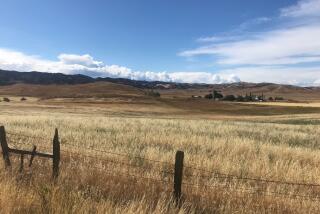Mountain Deemed Safe for Dump
- Share via
WASHINGTON — The U.S. Department of Energy gave a favorable safety assessment Tuesday to a plan to build an underground dump in Nevada’s Yucca Mountain to hold radioactive spent fuel from nuclear power plants for an estimated 10,000 years.
The DOE report, released late Tuesday, could be a key step toward getting administration approval of the controversial project. The proposal would face strong opposition Capitol Hill, especially from the new Senate majority whip, Harry Reid of Nevada.
The preliminary site evaluation finds that radiation levels from storing nuclear waste at Yucca Mountain would fall well below limits set by the Environmental Protection Agency, the report said.
The site in the Nevada desert would store thousands of tons of radioactive materials from nuclear power plants.
The report is “the most significant milestone accomplished to date in the federal government’s effort to develop a geological disposal facility,” said Joe Colvin, president of the Nuclear Energy Institute.
But the proposal has powerful enemies. Reid who now wields more clout as the Senate’s assistant majority leader, said he was disappointed but not surprised by the DOE study.
“The Department of Energy has long since made up its mind that it is willing to manipulate the science and cast aside any veil of objectivity in their zealous pursuit of shipping deadly radioactive waste through America’s heartland to Nevada,” Reid said in a statement.
“What the DOE has also failed to admit or address are the dangers inherent in shipping more than 70,000 tons of nuclear waste through our nation’s cities, towns and communities,” Reid said.
In a bow to Reid, the Democratic-led Senate Appropriations Committee in July slashed $125 million from Yucca Mountain’s development budget within the $25-billion energy bill for projects starting Oct. 1.
“The dose to the public and repository workers . . . would fall below the limits specified in the EPA radiation protection standards and proposed (Nuclear Regulatory Commission) requirements,” the report said.
In a statement earlier Tuesday, Energy Secretary Spencer Abraham pledged to make a decision on the facility “based on sound science.” A DOE recommendation on Yucca Mountain is due to the White House by the end of the year. Any proposal must still be reviewed by the NRC.
EPA Administrator Christie Whitman in June announced new standards for residents that live near the Nevada desert site. She said EPA will limit overall radiation exposure for citizens living near Yucca Mountain to 15 millirem per year. That level is roughly double the exposure from naturally occurring radioactive materials in brick houses, she said.
Assuming a 10,000-year life of the storage facility, the DOE study pegs radiation exposure at less than 1 millirem of radiation per year.
About $8 billion has been spent over the last 20 years to determine if Yucca Mountain will offer safe storage, with critics contending the studies have shown it is unsuitable.
“This project is already 12 years behind schedule,” Colvin said. “And after nearly 20 years of in-depth scientific investigation of every environmental facet of Yucca Mountain, there is no reason for further delay.”
More to Read
Sign up for Essential California
The most important California stories and recommendations in your inbox every morning.
You may occasionally receive promotional content from the Los Angeles Times.













